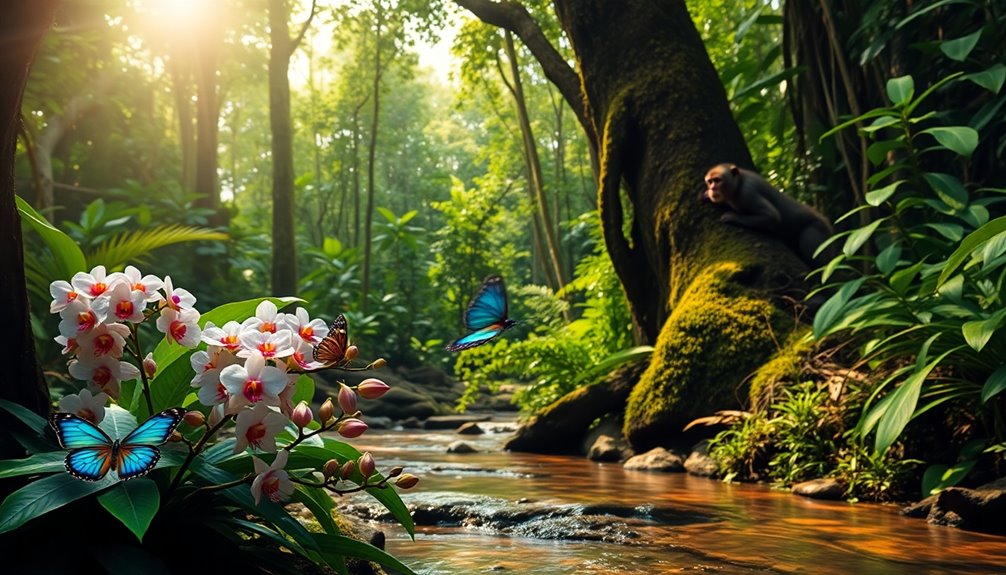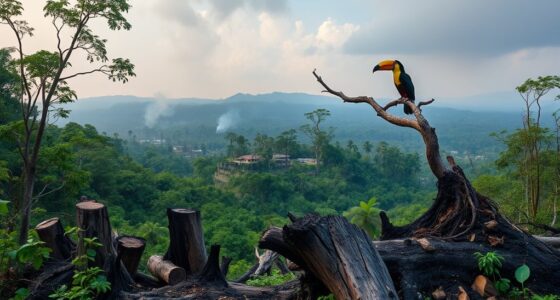Biodiversity means the variety of life on Earth, including plants, animals, fungi, and microorganisms. It covers over 8 million species, each playing an essential role in ecosystems. This diversity is significant for services like pollination, food production, and climate stability. When biodiversity declines, it threatens our food security and overall health. Understanding biodiversity is key to appreciating nature's balance, and there's much more to discover about why it matters.
Key Takeaways
- Biodiversity refers to the variety of life forms on Earth, including species, genetic, and ecological diversity.
- It encompasses over 8 million species, many of which are still undiscovered.
- Biodiversity is essential for ecosystem services like pollination, climate regulation, and food production.
- The decline in biodiversity threatens human health, food security, and environmental stability.
- Conservation of biodiversity is crucial to maintain ecological balance and resilience against changes.
What Is Biodiversity?

Biodiversity, the rich tapestry of life on Earth, encompasses the myriad of living organisms that share our planet. It includes species diversity, which refers to the variety of different species, as well as genetic and ecological diversity across ecosystems like forests, deserts, and oceans.
With over 8 million species estimated to exist, many still await discovery. This biodiversity is essential for ecosystem services, such as pollination and climate regulation, which support human well-being.
Conservation efforts are important to protect this diversity, as its loss threatens food security and ecosystem resilience. By recognizing the interdependence of species and their habitats, we can better appreciate the role biodiversity plays in maintaining a stable and thriving planet for all living beings.
The Importance of Biodiversity
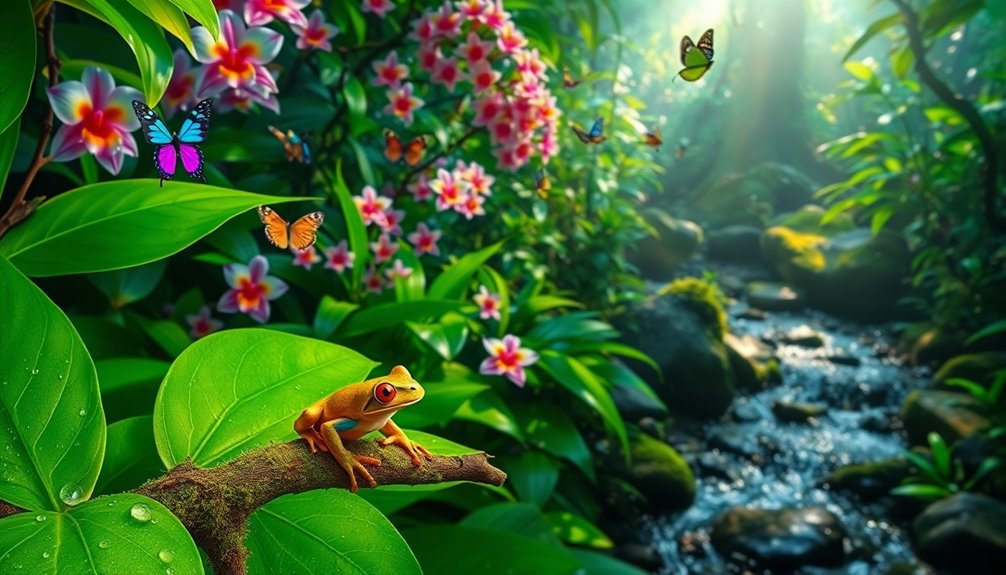
Life on Earth thrives because of the intricate web of biodiversity. The importance of biodiversity lies in its role in sustaining life on Earth through essential ecosystem services like pollination, climate regulation, and water purification. These services are essential for human well-being and survival.
Biodiversity conservation is critical, as it supports genetic diversity, which enhances ecosystem productivity and resilience. A rich variety of life forms helps stabilize environments, making them more adaptable to changes.
When biodiversity declines, it threatens food security and human health by reducing available resources. Additionally, the cultural and spiritual values tied to biodiversity contribute markedly to individual and collective well-being, underscoring the need to protect and preserve our planet's diverse life forms.
Types of Biodiversity

Understanding biodiversity involves recognizing its three main types: genetic, species, and ecological diversity. Each type plays a critical role in the health of ecosystems, and their conservation and management are crucial for stability.
| Type of Diversity | Description | Importance |
|---|---|---|
| Genetic Diversity | Variety of genetic info within species | Guarantees adaptability and survival |
| Species Diversity | Number and variety of different species | Enhances ecosystem resilience |
| Ecological Diversity | Variety of ecosystems in a region | Supports unique interactions |
The maintenance of genetic, species, and ecological diversity is very significant for sustaining ecosystem productivity and services, like pollination and nutrient cycling. By understanding these types, you can appreciate the intricate balance of nature.
Species Diversity Explained
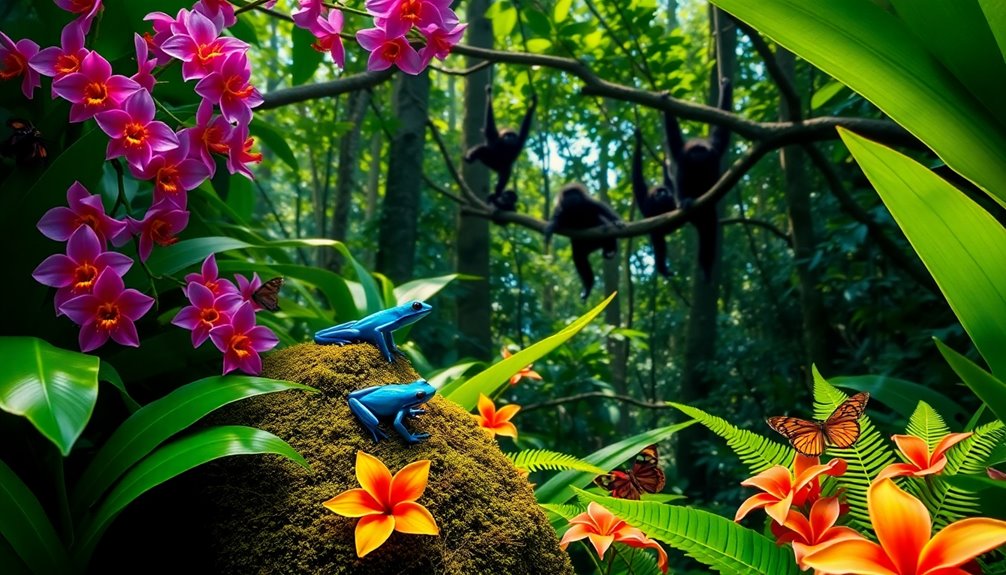
Understanding species diversity is key to grasping how ecosystems function and thrive.
You'll find that various factors influence this diversity, from climate to habitat availability, and each species plays a crucial role in maintaining ecological balance.
Importance of Species Diversity
While you may not realize it, species diversity is essential for maintaining healthy ecosystems. A rich variety of species enhances productivity and resilience, allowing ecosystems to better withstand environmental changes.
Take the Great Barrier Reef, for example, which houses over 9,000 species—showing just how important species diversity is in marine environments. High species richness contributes considerably to essential ecosystem services like pollination, nutrient cycling, and habitat stability, all critical for human survival.
When species diversity declines, ecosystems risk collapse, threatening food security and overall environmental health. This underscores the importance of conservation efforts to protect the variety of life on Earth.
Factors Influencing Species Diversity
Many factors influence species diversity in ecosystems, shaping the variety of life we see around us. Environmental factors like climate, habitat type, and geography play an essential role, with tropical regions often showcasing higher species diversity due to stable temperatures and abundant resources.
Nutrient availability in ecosystems is critical; richer soils support more plants, which in turn attract diverse animal species. The complexity of habitat structure, including different plant layers, creates niches that boost species diversity.
Disturbance regimes, such as fire or flooding, can temporarily enhance diversity by creating new habitats. However, human activities often lead to habitat loss and pollution, greatly affecting species diversity and increasing extinction rates, particularly in already biodiverse areas. Healthy ecosystems provide essential services that support both wildlife and human populations, highlighting the importance of maintaining biodiversity.
Conservation of Species Diversity
Protecting species diversity is essential for maintaining healthy ecosystems, as each species contributes uniquely to its environment. High species diversity enhances ecosystem productivity, making habitats more stable and sustainable.
Without these diverse species, ecosystems risk collapse, impacting food security and human health. You can support conservation actions that focus on preserving biodiversity hotspots, where species richness is highest.
Implementing strategies like creating protected areas and restoration projects helps maintain ecological balance. By prioritizing species diversity, you're not just safeguarding individual species but also ensuring the resilience of entire ecosystems. Additionally, fermented vegetable plates are a great way to celebrate local biodiversity while incorporating nutritious ingredients into your diet.
Join the effort to protect our planet's incredible variety of life, as each species plays a critical role in the intricate web of existence.
Understanding Genetic Diversity
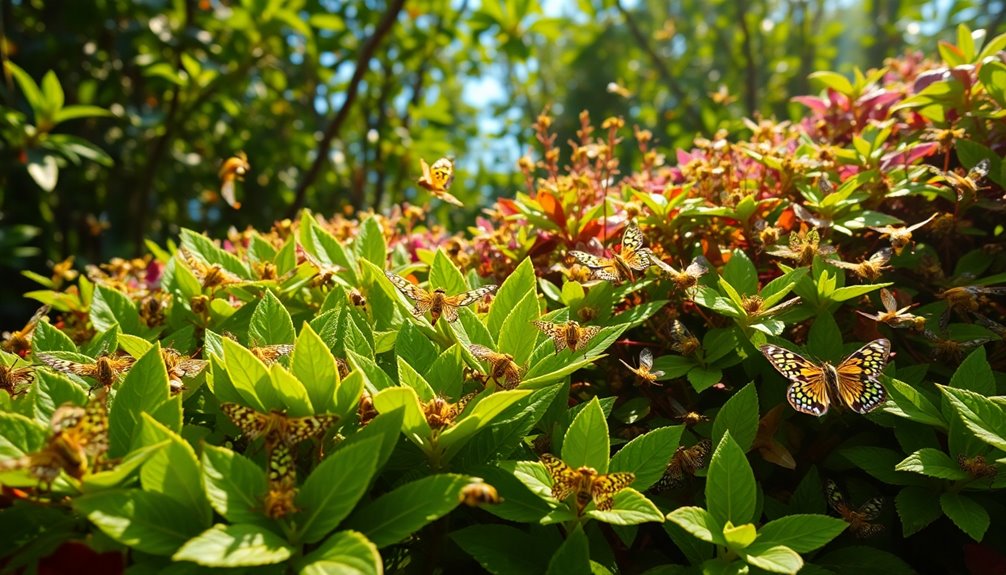
Understanding genetic diversity is essential to appreciating how species survive and adapt.
When you look at a population with varied genetic traits, you'll see a better chance of some individuals thriving in changing environments.
This variation is important for resilience against diseases and environmental threats, making it significant for the survival of species.
Importance of Genetic Variation
Genetic variation plays an essential role in the survival of species, as it equips populations with the ability to adapt to changing environments and resist diseases. High genetic diversity guarantees resilience against threats like climate change and habitat destruction.
It's imperative to conserve this diversity, as it directly impacts the sustainability for all life on Earth. The variation in genetic traits fosters evolutionary processes, allowing species to thrive across different ecosystems.
For instance, genetically diverse crops are more resilient to pests and diseases, which is critical for food security and economic stability.
Recognizing the ecological and economic significance of genetic variation can motivate efforts to maintain biodiversity, ultimately benefiting both current and future generations.
Genetic Diversity and Survival
Life on Earth thrives because of the variety found within species, which is key to survival in a constantly changing world.
Genetic diversity plays an important role in adaptation, allowing species to respond effectively to environmental changes and challenges. When populations possess high genetic diversity, their resilience to diseases and stressors increases, greatly boosting their chances of survival amid climate change.
For example, diverse crop species are critical in breeding programs aimed at creating disease-resistant varieties, ensuring food security.
Conversely, losing genetic diversity can lead to inbreeding, making populations more vulnerable to extinction.
As a result, conservation efforts, such as seed banks and wildlife corridors, are essential for maintaining genetic diversity and preserving the evolutionary potential of species.
Exploring Ecological Diversity

While exploring ecological diversity, you'll discover the rich tapestry of ecosystems that exist within a specific geographical area. This diversity encompasses various habitats like forests, deserts, wetlands, and oceans, each supporting unique communities of organisms.
High ecological diversity enhances ecosystem productivity and stability, allowing these ecosystems to withstand environmental changes and recover from disturbances. For instance, India showcases significant ecological diversity, housing two biodiversity hotspots that contribute to its biological richness.
Ecosystems with high ecological diversity provide essential services such as water purification, soil fertility, and climate regulation—crucial for human survival.
Economic Benefits of Biodiversity
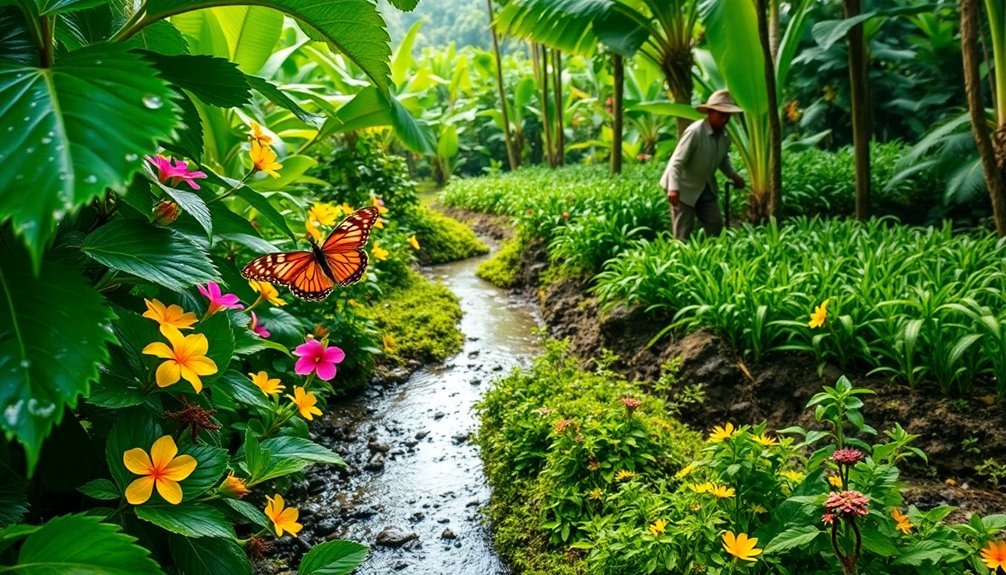
Ecological diversity not only supports the health of ecosystems but also plays a significant role in driving economic benefits. Biodiversity provides essential resources for food and healthcare, with around 50% of modern medicines derived from natural compounds. Diverse species enhance agricultural productivity and resilience, leading to increased yields and reduced reliance on chemicals. Additionally, national parks and biodiversity hotspots draw millions of tourists each year, boosting local economies through ecotourism and conservation-related jobs. Furthermore, the variety of plant species contributes to agricultural productivity, ensuring that crops can adapt to changing environmental conditions.
| Economic Benefits | Examples |
|---|---|
| Food Security | Diverse crops and fisheries |
| Healthcare Resources | Medicines from natural compounds |
| Tourism | National parks and ecotourism |
| Agricultural Productivity | Crop improvement and resilience |
Biodiversity and Ecological Stability
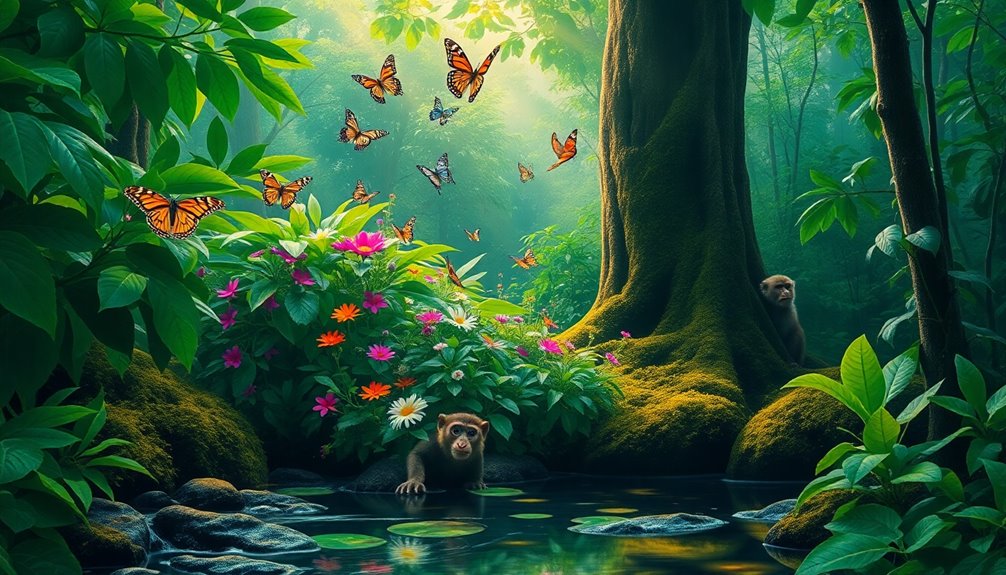
Biodiversity acts as a cornerstone for ecological stability, ensuring that various species play unique roles within their ecosystems. High species diversity enhances resilience, helping ecosystems recover from stressors like climate change and habitat destruction.
Each species contributes to vital processes such as energy capture, nutrient cycling, and decomposition, maintaining ecological balance. When you have diverse ecosystems, they can utilize resources more efficiently, leading to increased productivity and higher biomass levels.
However, a loss of biodiversity threatens essential ecosystem services like pollination and water purification, impacting both wildlife and human populations.
Threats to Biodiversity

When you think about biodiversity, it's essential to recognize the threats it faces today.
Habitat destruction, climate change, pollution, and invasive species all play significant roles in diminishing ecosystems and wildlife.
Understanding these challenges can help you appreciate the importance of preserving the natural world.
Habitat Destruction Effects
As human activities continue to reshape the planet, habitat destruction emerges as one of the most pressing threats to biodiversity. This destruction, driven by urbanization, agriculture, and deforestation, leads to significant biodiversity loss and puts approximately 1 million species at risk of extinction.
With over 70% of Earth's land altered, fragmented habitats disrupt species migration and reproduction, further exacerbating the crisis. Coastal ecosystems, like mangroves and coral reefs, face the highest vulnerability, losing over 50% in recent decades.
Beyond wildlife, habitat destruction compromises essential ecosystem services, such as water purification and climate regulation, which are vital for our survival. Urgent conservation efforts are needed to mitigate these impacts and protect the planet's rich biodiversity.
Climate Change Impact
Climate change poses a profound threat to the delicate balance of ecosystems, making it increasingly difficult for many species to survive. As temperatures rise, you may notice shifts in species distribution and increased extinction risks. Approximately 1 million species are at risk due to habitat loss and altered ecosystems.
Here are three key impacts of climate change on biodiversity:
- Marine Biodiversity: Ocean acidification endangers coral reefs, which support about 25% of marine species.
- Disrupted Behaviors: Changes in climate patterns affect migratory and breeding behaviors, leading to mismatches in food availability.
- Complex Conservation Efforts: Existing threats like habitat destruction and pollution are exacerbated, making conservation efforts more urgent than ever.
Your awareness and action can help protect our planet's biodiversity.
Pollution and Invasive Species
Pollution and invasive species pose significant threats to biodiversity, impacting ecosystems and the delicate balance of life they support. Pollution from industrial waste and agricultural runoff contaminates water, harms wildlife, and disrupts food chains, leading to biodiversity loss. Invasive species, like zebra mussels and Asian tiger mosquitoes, outcompete native species for resources, diminishing genetic diversity and altering ecosystem dynamics. This not only weakens resilience against environmental changes but also incurs economic costs, over $120 billion annually in the U.S. alone.
| Threat Type | Impact on Ecosystems | Consequences |
|---|---|---|
| Pollution | Contaminated water | Loss of wildlife |
| Invasive Species | Outcompetes natives | Reduced genetic diversity |
| Combined Effects | Ecosystem collapse | Increased extinction risk |
Biodiversity in India
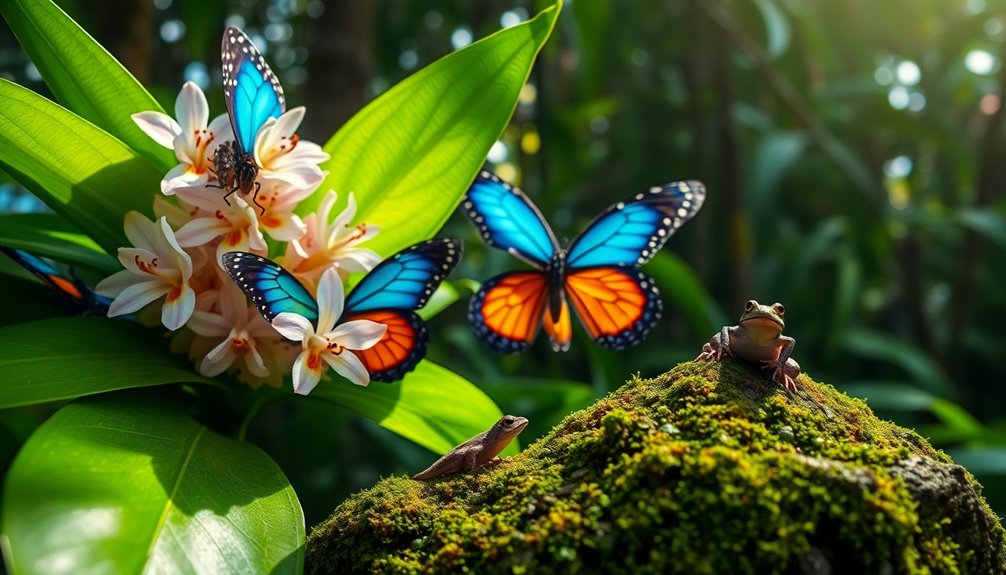
India boasts an incredible wealth of biodiversity, ranking ninth globally for plant species richness.
You'll find a vast variety of plant and animal species across its diverse ecosystems. This richness isn't just about numbers; it's essential for maintaining genetic diversity and ecological balance.
However, rapid declines in species and habitats are alarming, making conservation efforts imperative.
Here are three key aspects of biodiversity in India:
- Rich Ecosystems: Home to two biodiversity hotspots—the Western Ghats and Eastern Himalayas.
- Animal Species: Approximately 91,000 animal species call India home, contributing considerably to global biodiversity.
- Agricultural Heritage: India is the origin of critical crops like pigeon pea and cotton, fundamental for agriculture.
Protecting this natural heritage is more important than ever!
Frequently Asked Questions
What Is Biodiversity in Short Term?
Biodiversity refers to the variety of life forms on Earth, including plants, animals, fungi, and microorganisms.
It's about the different species, genetic differences within those species, and the various ecosystems they inhabit.
You'll find that this diversity is vital for maintaining ecological balance, supporting services like pollination and nutrient cycling.
Without it, ecosystems can collapse, leading to serious consequences for food security and our overall well-being.
Preserving biodiversity is essential for future generations.
What Is the Simple Word for Biodiversity?
The simple word for biodiversity is "variety." It captures the essence of the different life forms you encounter, from plants and animals to fungi.
When you think about variety, consider how these diverse species interact within ecosystems, creating balance. This variety isn't just important for nature; it also supports services you rely on, like clean air and food.
Embracing this variety enriches both your life and the planet's health.
What Is Biodiversity in Biology for Kids?
Imagine a colorful garden full of different flowers, insects buzzing around, and birds singing. That's what biodiversity is like!
In biology, it means all the different plants, animals, and tiny creatures living together on Earth. Each one plays a part in keeping our planet healthy.
You've got species diversity, genetic diversity, and ecological diversity, all working together like a vibrant team.
Protecting this rich variety is essential for our survival and the planet's future!
Which Best Describes Biodiversity?
Biodiversity best describes the variety of life forms on Earth, including different species, genetic variations, and ecosystems.
You'll find it in forests, oceans, and deserts, where countless organisms interact. This diversity is essential for a healthy planet, supporting services like pollination and disease regulation.
When you appreciate biodiversity, you recognize its significance for human survival and well-being. Protecting it helps guarantee healthier ecosystems for generations to come, benefiting all life on Earth.
Conclusion
In summary, biodiversity is the lifeblood of our planet, weaving together a vibrant tapestry of life that sustains us all. By protecting it, we guarantee not just the survival of countless species, but also our own future. Every loss in biodiversity is like pulling threads from a masterpiece, unraveling the beauty and balance of nature. So, let's be stewards of this incredible resource, championing its preservation for generations to come. Together, we can make a difference!
